#General Supremo
Explore tagged Tumblr posts
Text

new oc:3
19 notes
·
View notes
Text

Special Poster ''The Divinities Dragon Ball Universe''!
#Special Poster ''The Divinities Dragon Ball Universe''!#Special Poster ''The Divinities DBU''!#Poster ''The Divinities Dragon Ball Universe''!#Poster ''The Divinities Dragon Ball''!#Supremo/Kami/Dio#Balzar/Karin#Re Enma/Re Yammer#Re Kaioh del Nord/King Kai of the North/Re Kaioh of the North#Gran Maestro Re Kaioh/Grande Re Kaioh/Dai Kaiō#Kaioshin dell'Est/Kaioshin Il Superiore/Shin/Divinità della Creazione#Lord Beerus/God of Destruction Beerus/Il Signore della Distruzione/Beerus the Destroyer/Beerus/Beers/Bills/Divinità della Distruzione#Dragon Ball#Dragon Ball Z#DBZ#Dragon Ball Super#DBS#Dragon Ball Universe#Dragon Ball General
41 notes
·
View notes
Text

General supremo on paperwork duty
#pvz#pvz fanart#pvzGW2#pvzGW#plants vs zombies#garden warfare#plants vs zombies garden warfare#General supremo#this took way too long#LORD HAVE MERCY ON MY HANDS
57 notes
·
View notes
Text
PASCUA MILITAR 2025. NADA QUE CELEBRAR General de División (R.) Rafael Dávila Álvarez
Pascua Militar: conmemoración de la expulsión de los británicos de Menorca Las circunstancias no son muy favorables para celebrar una Pascua Militar con la alegría que le corresponde a la festividad que goza de mayor tradición en nuestros ejércitos. Es el día en el que los soldados están más cerca de su Rey, el día que al Rey le corresponde dirigirse a ellos como mando Supremo de los Ejércitos…

View On WordPress
#as Fuerzas Armadas#El Estrecho de Gibraltar#El Sahel#el viejo y lamentable BMR#En la indisoluble unidad de la naci��n española#General de División (R.) Rafael Dávila Álvarez#l riesgo de conflicto bélico#la base militar de Gibraltar#la catástrofe de Valencia#la industria de Israel#la pascua militar#mando Supremo de los Ejércitos#Marruecos#Pascua Militar#rafael davila alvarez#relaciones en el Magreb#Tess Defence#una ong con pistolas#vehículo de transporte en combate del Ejército de Tierra 8x8
1 note
·
View note
Text
Steddie Wiggly Wednesday🪱🐛🪱🐛
Thanks for the tag @wheneverfeasible and @medusapelagia and possibly some other lovely moots. Sorry, I move in ice ages!
CW for original character death. Don't worry, Steddie and all canon characters are safe.
☁��☁️☁️☁️☁️☁️☁️☁️☁️☁️☁️☁️☁️☁️☁️☁️☁️☁️
Steve has an older brother, Cal, less than two years older than him. He loves his brother and hates his guts because Cal is stupidly perfect.
Not just grade A student perfect and state championship tennis finals perfect. Cal is so ridiculously, effortlessly nice. He floats above the High School popularity monster on some cotton-candy cloud of perfection—so high above all the shit that he can play Dungeons and Dragons with Eddie ‘freakshow’ Munson every week and walk away untarnished.
Steve’s pretty popular too, but he’s laboring for it the hard way— hanging with the ‘right’ crowd, dating the ‘mean’ girls. He’s sweating it out on the basketball court, barely scraping through the classes that Cal aced. Of course, his parents are pissed, and he knows he’ll never emerge from Cal’s perfect shadow. Cal secretly gave Steve all his old class notes to copy and offered to coach him, but Jesus, who’s gotten time for that shit?
So yeah, Steve hates Cal, and he loves him too. When Steve figures he might be bi, he’s in need of his brother like never before, though can’t find the right words. He’s got a dumb crush on Tommy H and… Ugh, it’s not like he can tell Tommy, and even when Steve gets over his crush, nobody in Hawkins is gonna accept that kind of shit.
Naturally, his perfect brother sees when Steve stops hanging with Tommy and the others. Sees when Steve stops dating. On that spring night, when it’s only the two of them and a sixpack at home by the pool, Cal knows. Even before Steve starts to inarticulately explain how confused and screwed up he is. Even before Steve tells Cal he’s over Tommy, but he’s definitely queer, and faking being the Steve Harrington the world wants to see is killing him. He’s failing his classes, and Hargrove is humiliating him on the basketball court. Steve’s got a totally messed up crush on Billy too, even though the guy treats him like dirt. Steve is scared Billy knows, and… Crap, why is his life such a mess?
He cries. He hates himself for it, but he cries, and it’s okay, because he’s got his brother, and he hates how perfect Cal is. But Cal is always gonna be there, and he’ll always have his back.
Cal is off to MIT in the fall. So yeah, that’s gonna suck, until… Cal doesn’t go. Instead, he gets sick.
Really sick. Steve’s worried, but this is Cal, he’s perfect. Everyone says that Cal is gonna ‘beat it.’ As if, because he’s a good person, he’s going to somehow exert his magic over whatever fucked-up biology is destroying his body.
Cal has three months to live.
Eddie is devastated. It was supposed to be Cal’s final campaign before he ascended to the higher plane of an Ivy League school. Now it’s simply final.
Suddenly, Eddie is moving Hellfire Club to Hawkins General Hospital, and then hosting it at the fucking Harrington’s. Nobody is shrieking or dousing him in Holy Water, and it would be hilarious, if it wasn’t so horrible. Obviously, Eddie is determined to make it the greatest, most metal campaign he’s ever conducted. He’s crumbling inside. They all are. These are the last days he gets to share with the guy from the ‘right’ side of the rails who looked at Eddie and saw Eddie, rather than the con-supremo-spawn of Al Munson.
Cal’s a-hole kid brother, Steve, starts hovering around when they’re playing. For obvious reasons. He needs to cling to every last moment with Cal, too. Lurking in dark corners, Steve starts staring at Eddie so hard it gets creepy. Eddie knows he’s pretty magnetic when he’s in full-on DM mode, but this is weird. Obviously, Steve must want ‘in,’ so Eddie reluctantly offers to help him draw up a character card, and… shock horror.
Steve Harrington isn’t that much of an a-hole. Now, it’s just the two of them, laughing and sketching and conjuring with D and D ideas, and Steve’s oddly jumpy. He doesn’t seem to be able to look Eddie in the eye, keeps staring at Eddie’s mouth, then touching his own, licking his lips. Eddie is… confused. Steve Harrington is cute. He is also supposed to be a repellent jock—not this guy who swerves maniacally between hilariously bitchy sniping and self-effacing over-apologies.
Once Eddie gets Steve going in Hellfire, Steve is stupidly over-confident, almost back to dumbass-Steve-the-jock. Eddie has a billion chances to slaughter him, and he refrains. For Cal.
Oh, and because, Eddie’s got a stupid crush on his friend’s kid brother. He figures out there is barely a year age gap between him and Steve, though. Cal was old in his year group, and Eddie one of the younger ones.
Still irrelevant. Steve is straight. Eddie’s 100% sure. Well, he would be, if Steve would stop blushing and glancing away whenever Eddie seeks eye contact.
Then Cal calls Eddie one night, asks him to come over. Cal’s getting sicker, so he detonates the bombshell.
You’d be perfect for my brother, man.
What the fuck?
Okay, so he doesn’t press Cal for details. It’s implied that Steve is into guys, but… Woah! Too much! His sick friend wants him to date his younger brother? Like, a dying wish? Yeah, Eddie likes Steve, and now he’s starting to read Steve’s feelings into the way Steve acts around him. But no way are they perfect for each other.
He gives it a shot.
On their first date, Eddie takes Steve to a dive bar Cal used to love more that it deserved, and where Eddie sometimes performs with Corroded Coffin. They make out around the back, against some dingy brick wall. They’re slightly drunk, and the kiss is wet and messy, and they’re stupid happy and then both so stupid sad that they stop trying not to be. They can’t kiss away the pain, but they can kiss. They cry so hard.
Eddie has found another Harrington brother who actually sees him. It occurs to him, more gradually, that he’s the only person in the world, other than Cal, who actually sees Steve.
What the fuck AGAIN?
And then he’s the only person left in the world who sees Steve, and besides Wayne, Steve is the only person left who really sees Eddie.
Steve loves Cal so much, and he hates him. He was so fucking perfect that he couldn’t possibly ditch his little brother without setting him up with a soulmate.
🪱🐛🪱🐛
My ST fic on AO3
no pressure tags: @mugloversonly @tea42 @fuctacles @queenie-ofthe-void
#steddie#steve x eddie#steve and eddie#Steve Harrington#Eddie Munson#wriggly wednesday#wiggle wednesday#steddie au
207 notes
·
View notes
Text
NEL MIO PICCOLO SERVE INCAZZARMI?

Io e i miei amici di una vita potremmo essere pagati per accettare di essere inseriti in allegato al DSM-6 di prossima uscita, affinché ogni specializzando in psichiatria e psicologia potesse comprendere quanto non ci sia un limite al numero di disturbi mentali con i quali un singolo individuo possa psico-flagellarsi.
Per esempio, in un'ora e diciannove minuti io e il mio amico @salfadog non abbiamo individuato un modo univoco e sicuro per salvare il mondo ma una cosa è certa: abbiamo deciso che dobbiamo salvare il mondo.
Badate, non sto scherzando.
Il fatto è che a livello percettivo, un'affermazione del genere evoca tre tropi classici della letteratura cinematografica:
L'eroe inarrestabile che in maniera indefessa sacrifica tutto se stesso per il bene supremo dell'umanità.
Il villain che vuole annientare l'universo intero per salvarlo da se stesso poiché oramai troppo corrotto per essere recuperabile.
Il tizio con la campanella in mano e il cartello THE END IS NEAR che a Central Park arringa la folla di due casalinghe con neonato e finisce in una cella imbottita imbottito di torazina.
Facciamo che per phisique du role e/o pudore io e lui non si rientri in nessuna delle tre categorie sopracitate, quindi ci siamo fatti una domanda...
Il mondo ha bisogno di essere salvato?
No
(è stata la risposta condivisa... e per 'mondo' intendiamo sia il pianeta che l'umanità)
Ognuno di noi potrebbe decidere di non fare nulla - che poi alla fine è quella la sensazione, se non proprio la realtà dei fatti - e sia il pianeta che l'umanità andrebbero tranquilli per la propria strada evolutiva.
Certo, magari farebbe un po' più caldino e i rifugi sulle alpi avrebbero la loro spiaggia tropicale con meduse, coralli e pesci pagliaccio ma il fatto è che se il globo terracqueo e la globalità umana negli ultimi 100.000 anni sembrano essere andati tranquilli in avanti scuotendosi la polvere dalla spalla come un millenario Luke Skywalker, questo non significa che non vi sia stato il sacrificio di molti per portare avanti i pochi.
A me il fascismo fa molto paura.
Il problema è che non è lo stesso fascismo che fa paura a molti altri.
Nella Treccani il fascismo viene definito come '... una concezione religiosa, in cui l'uomo è veduto nel suo immanente rapporto con una legge superiore, con una Volontà obiettiva che trascende l'individuo particolare e lo eleva a membro consapevole di una società spirituale' ed è proprio in virtù di questo concetto che mi sento di puntare il dito contro una certa visione semplicistica della realtà: fascista non è colui che difende la razza, i confini o l'italianità e vota Fratelli d'Italia... fascista è colui che divide la realtà in due parti e auspica l'annientamento di quella sbagliata. L'altra.
Sembra semplicistica come definizione ma al netto di tutti i paradossi di Popper (vedete di capire cosa sia veramente il paradosso di Popper e non copia-incollate da facebook) alla fine, per sua stessa natura si tratta sempre dello stesso metodo coercitivo di controllo in nome del giusto contro lo sbagliato, la trappola dialettica e sociale in cui cadono tutti.
'Il fascismo non è un opinione, è un crimine'
Coi fascisti non si parla, li si mena.
I partigiani hanno sconfitto i nazi-fascisti coi proiettili e non con le parole.
Io però mi chiedo una cosa, ripetuta nel corso degli anni, che ha sempre avuto la stessa risposta.
Ma tu cosa stai facendo contro il fascismo?
Bada bene, 'tu' collettivo della domanda diretta: io non ti conosco, so solo che sei arrabbiato per un bel po' di ingiustizie ma anche verso alcune persone ipocrite, privilegiate e potenti che contribuiscono ogni giorno a fratturare il mondo in due.
Sì ma oltre a questa consapevolezza, tu cosa stai facendo?
Bada bene ancora, 'tu' collettivo della domanda diretta: la lamentela fine a sé è sacrosanta, catartica e drenante via il veleno dal corpo ma una volta che la piccola bolla che avviluppa ognuno di noi è risuonata dell'eco delle ingiurie, il fascismo è forse diminuito? La tua rabbia ha fatto cambiare idea a qualcuno? Hai 'salvato' qualche vittima?
Non è la prima volta che scrivo quanto andrò ad affermare e non è la prima volta che a fronte di un certo numero di persone d'accordo, puntualmente si palesano quelli che mi spiegano perché sto sbagliando e che i fascisti vanno sempre menati. Pazienza.
Una volta mi trovavo su un autobus e c'era questo uomo di una certa età che stava inveendo contro una ragazza mediorientale, non so per quale motivo ma coi soliti argomenti che puntavano al fatto che se ne doveva tornare al suo paese. La ragazza era spaventata, tutti si facevano i fatti propri e io sono intervenuto come sono sicuro che tutti e tutte voi sareste intervenuti/e ma a differenza di altre volte in cui mi sarei scagliato contro il vecchio benito, mi sono messo invece in mezzo ai due voltandogli le spalle e sorridendo alla ragazza, chiedendole come si chiamasse e chiaccherandoci tranquillamente.
Nessuno scontro, nessuna coercizione, nessuna differenza di valori gettata in faccia ad alcunchì ma una persona sola che non era più sola, anzi, due persone sole, perché io non credo nella malvagità intrinseca del cane cattivo ma nella paura del cane spaventato. E se avessi avuto tempo avrei parlato anche a lui: certo, potevo scoprire che si trattava di una testa di cazzo inguaribile o magari intuire mille altri dolori e solitudini che non avrei mai toccato se gli avessi urlato contro. O lo avessi menato.
Avrei fatto la stessa cosa con un balilla anfichiodato e una mazza con su scritto DUX MEA LUX?
Se un cane mi sta mordendo non gli faccio il 'resta!' col premietto ma mi difendo, quindi vi pongo l'ultima domanda: tutti ma proprio tutti i 'fascisti' mordono oppure è più semplice fare di tutta l'erba un fascio (ba dum tss) e menarli noi per primi?
La risposta che vi darete mi interessa nella misura in cui possa essere più o meno venata di dubbi dall'ultima volta che ve la siete fatta ma non dovete rendere conto a questo perfetto sconosciuto con la campanella, il cartello e poca torazina in corpo... dovete rispondere a quelle persone che avevano bisogno di parole rivolte a loro e non di insulti urlati ad altri, di gentilezza nei loro confronti e non di violenza nel loro nome, dell'inclusione che comprende e non del sacro furore che divide.
Io la mia scelta l'ho fatta già da tempo e non mi interessa vederne i frutti maturi da riempirne le ceste, mi basta quell'unico fiore che aveva paura di sbocciare e alla fine c'è riuscito perché aveva solo bisogno di qualcuno che lo rimirasse.
Grazie della pazienza <3

@salfadog
39 notes
·
View notes
Text

I try to make it comprehensible for anyone new to PvZ :)
If you told me 8 months ago that I would have a pvz fic series as a side thing I would've laughed but now I would cry
#also because pvz only has enough proper lore to fit on a teaspoon#especially the shooters#the lack of actual characters outside of dave and zomboss means you can just kinda go buckwild with making ocs#so it's basically just me giving PvZ the lore it should've had#and good news I got better in the span of 7 works#it's good practice#except maybe general supremo#because he's just me giving a variant lore that I think should've had more lore
4 notes
·
View notes
Text


my contributions to this year's draw drarry badly challenge- general romance and also the scene in draco malfoy, toilet supremo that absolutely broke me.,.. such a funny fic. this challenge is so genius, what an amazing idea!!
30 notes
·
View notes
Text
Random Doctor Who Facts You Might Not Know, Part 57: Gallifrey at War Part 8
Normal TWs for these parts apply: for war, death, injury, disturbing behavior
The Gramoryans were paradox eaters that used to be monitored by the Time Lords but began to run amok after the Last Great Time War. They collected important historical people and kill those who they deemed insignificant. They were attracted to Tudor Era England when the Monk disguised himself as King Henry VIII. (Audio: Divorced, Beheaded, Regenerated)
Paradox anxiety refers to the fear of falling under the influence of the Faction Paradox if someone caused a paradox. In more extreme cases, people might believe they had already caused a paradox and were thus already under Faction Paradox control. (Novel: The Book of War)
While not a declared "war" that Gallifrey took part in, the Quantum Archangel was created by fusing a human with the energy of the Lux Aeterna, the quantum foam making up reality. This resulted from the Master trying to use a TITAN Array to rejuvenate his body and destroy the Chronovores. The Quantum Archangel became basically an omnipotent goddess with the ability to create pocket universes and rewrite history. She intended to get rid of suffering by putting everyone in their own individual pocket universes and letting them live their best lives possible. (Novel: The Quantum Archangel)
The Quantum Archangel did not realize that the Chronovores would start to eat the small alternate timelines she had been creating. The perfect universes collapsed into nightmarish versions. (Novel: The Quantum Archangel)
To fight the Quantum Archangel, the Sixth Doctor bathed in the Lux Aeterna himself to get the same powers. He went to the higher dimensions and tried to make her see reason. This failed, so the two of them did battle on a truly cosmic scale, using entire suns and planets as weapons. The Doctor in his godly form and Kronos managed to revert the Quantum Archangel back into her human form (Novel: The Quantum Archangel)
The Ninth Doctor told Rose he was 900 years old because during the Last Great Time War, such as during the Battle of Rodan's Wedding, years became ammunition. The Doctor could remember being aged to five million years old when hit by one volley of shrapnel and then being de-aged to a baby by the next. Because of this mess, the Doctor could not be sure of his exact age but decided that he "felt" about a thousand years old, which he rounded to 900. (Short story: Doctor Who and the Time War) If you recall from TV: The Invasion of Time, Rodan was a Gallifreyan who was responsible for maintaining the transduction barrier.
The Bygone Horde was made up of all the species that had been erased from existence during the Last Great Time War, surviving only as a memory. They planned on returning to existence using the sacrifice of the human race, but the Ninth Doctor and Adam Mitchell stopped them. (Audio: The Other Side)
Ollistra attached an artron leash to the War Doctor, thus linking him to herself. These artron leashes were made by Gallifrey and forced the person on the receiving end - in this case the War Doctor - to stay close to the other. If they moved too far away, they would be given an intense electric shock. (Audio: A Thing of Guile)
The Fifth Doctor was forced to lead a military campaign against Morbius during the Civil War. He took on the alias the Supreme Coordinator (or the Supremo) and led a large army composed of Ice Warriors, Draconians, Sontarans, Ogrons, and Cybermen. The Daleks were not part of this Alliance, but the Doctor had a nightmare where they offered to help. (Novel: Warmonger)
The Ogrons had been the Doctor's bodyguards in this time in order to avoid jealousy that choosing one of the other species would have caused. (Novel: Warmonger)
Peri Brown had become a guerilla leader on Sylvana after the Doctor had sent her away to heal from a serious injury. She only met back up with the Doctor after he became general of his massive army. (Novel: Warmonger)
The Supreme Coordinator had such a big impact on those in his command that the Sontaran Battle Major Streg sacrificed himself to save the Supremo in battle. His last words were ones of thanks to the Supremo for giving him a glorious death in a legendary battle. (Novel: Warmonger)
An additional Time War was averted during the Eleventh Doctor's era. This clearly caused the Doctor a lot of distress, causing him to break down alone in his TARDIS and speak about how he didn't want to be a Warrior again. (Audio: Daleks Victorious)
A predicted timeline of this averted Time War suggested by a sentient Dalek time machine (named Tim) stated that the best end to this war (and the way to destroy the Daleks) would involve Valarie going back in time and changing her own personal history. Even in this best case scenario, however, the Time War would last billions of years and result in the Doctor’s death. (Audio: The Last Stand of Miss Valarie Lockwood)
The Loomstacks on Gallifrey 8 became so overworked during the War in Heaven that thick black smoke blocked out the sun over the Capitol. To create more troops for the War, Gallifrey would incinerate their dead soldiers, break their bodies into raw fabric, and reweave them into brand new troops. (Novel: The Taking of Planet 5)
First 1 Prev 56 Next 58
#doctor who#dw#dr who#classic who#new who#big finish#big finish doctor who#big finish audios#doctor who expanded universe#dw eu#doctor who eu#eighth doctor#fifth doctor#sixth doctor#the master#war doctor#ollistra#gallifrey#morbius#eleventh doctor#ninth doctor#rose tyler#valarie lockwood#peri brown#the meddling monk#the monk#faction paradox#the war in heaven#war in heaven#time war
53 notes
·
View notes
Text
Top 15 Evil Clowns

There are many fears one might consider “popular phobias.” These are terrors that are not only common amongst people in general, but frequently used, abused, and homaged in various works of popular media. They’re the sources of many famous movies and monsters. Among these popular fears you’ll see folks return to time and time again are arachnophobia, ophidiophobia, galeophobia (look up what all those words mean, I’m not telling you here)...and, of course, coulrophobia. The Fear of Clowns.
In reality, most clowns are not scary at all. They’re figures of fun and whimsy intended to make people laugh and entertain children. They work hard to practice their craft and usually do what they do either for want of money, or love of their career, or even both. However, over time, the imagery of the clown has become increasingly negatively stereotyped, to the point where it’s actually really hard to find genuinely friendly, humorous clown characters in fiction that have a lot of impact. There are a few, mind you - Bozo, Ronald McDonald, and Clarabell are three hopefully recognizable “good clown” names - but nowadays, most people see clowns in the same vein as zombies or vampires. Their innocent origins now seem almost forgotten, and as a result, the fear has become even more intense.
It’s not surprising, to be fair, that the clown has become so synonymous with evil as opposed to happiness. As many have pointed out (who are wiser than I), their heavily made-up faces and flamboyant costumes not only make for eye-catching and iconic visual elements, regardless of the circumstances, but can also make it difficult for people - especially very young people - to fully “connect” with them. As humans, we rely on certain features and physical attributes to tell what others are thinking or intending, and when they are covered up especially heavily, we naturally become unsettled. Beyond this, however, there’s also a wonderful dichotomy inherent to the idea of the Evil Clown: it’s the mismatch between the colorful, often humorous exteriors and the dark, horrific internal processes going on. They can be silly and fun, but they can also be dangerous. This applies to every form the iconography can take, from cartoon baddies to horror film bogeymen.
While I, myself, have no inherent fear of clowns, I’ve always found the idea of the Evil Clown to be fascinating. So, I thought it would be fun, as part of my October-fest of lists for 2024, to cover the topic and name some of my personal favorite examples of the trope. Some are scary, some are just cartoonishly nasty, but all of them universally give clowns a bad name. So, without further ado, here are My Top 15 Favorite Evil Clowns!

15. The Birthday Bandit, from Teamo Supremo.
Of all the characters on this list, the Birthday Bandit is arguably the least threatening, and one of the least well-known. While both of these facts hamper his ranking, he’s still worth mentioning. “Teamo Supremo” was a children’s superhero series made by Disney, inspired by a combination of old superhero shows from the 60s and 70s, and the works of Jay Ward - the creator of Rocky & Bullwinkle, George of the Jungle, and Dudley Do-Right, among other things. It focused on the adventures of three child superheroes; one of their most popular antagonists was the Birthday Bandit. The Bandit was a disgruntled children’s entertainer who turned to crime; while he mostly targeted birthday events, he would also strike on holidays and other special occasions. The main thing that makes the character so memorable, in my opinion, is voice: the Bandit was played by none other than Mark Hamill…and don’t worry, we’ll get to a certain OTHER famous clown of cruelty Hamill has played later in the list. We’re just getting started, ladies and gentlemen…

14. The Clown at Midnight.
This somewhat obscure horror-mystery venture was a made-for-TV film originally produced in Canada. Depending on where you look, the release date is listed as either 1998 or 1999, my guess being depending on the country you look at. While by no means a masterpiece of morbidity, it’s still a decently creepy adventure, in my opinion. The story begins when a young lady named Kate learns she is the daughter of a former opera star, who was killed under mysterious circumstances. She and her friends decide to try and restore the old opera house where her late mother worked. However, things take a turn for the deadly when a mysterious killer, dressed a clown, begins to stalk the teens and their teacher. Kate and her friends must try to figure out who is behind the makeup, while also attempting to stay alive. I won’t give away who the Clown is, or why they’re doing what they’re doing, but it’s the actor involved and the clown himself, as well as the atmosphere of the old opera house, that makes this movie worthwhile.
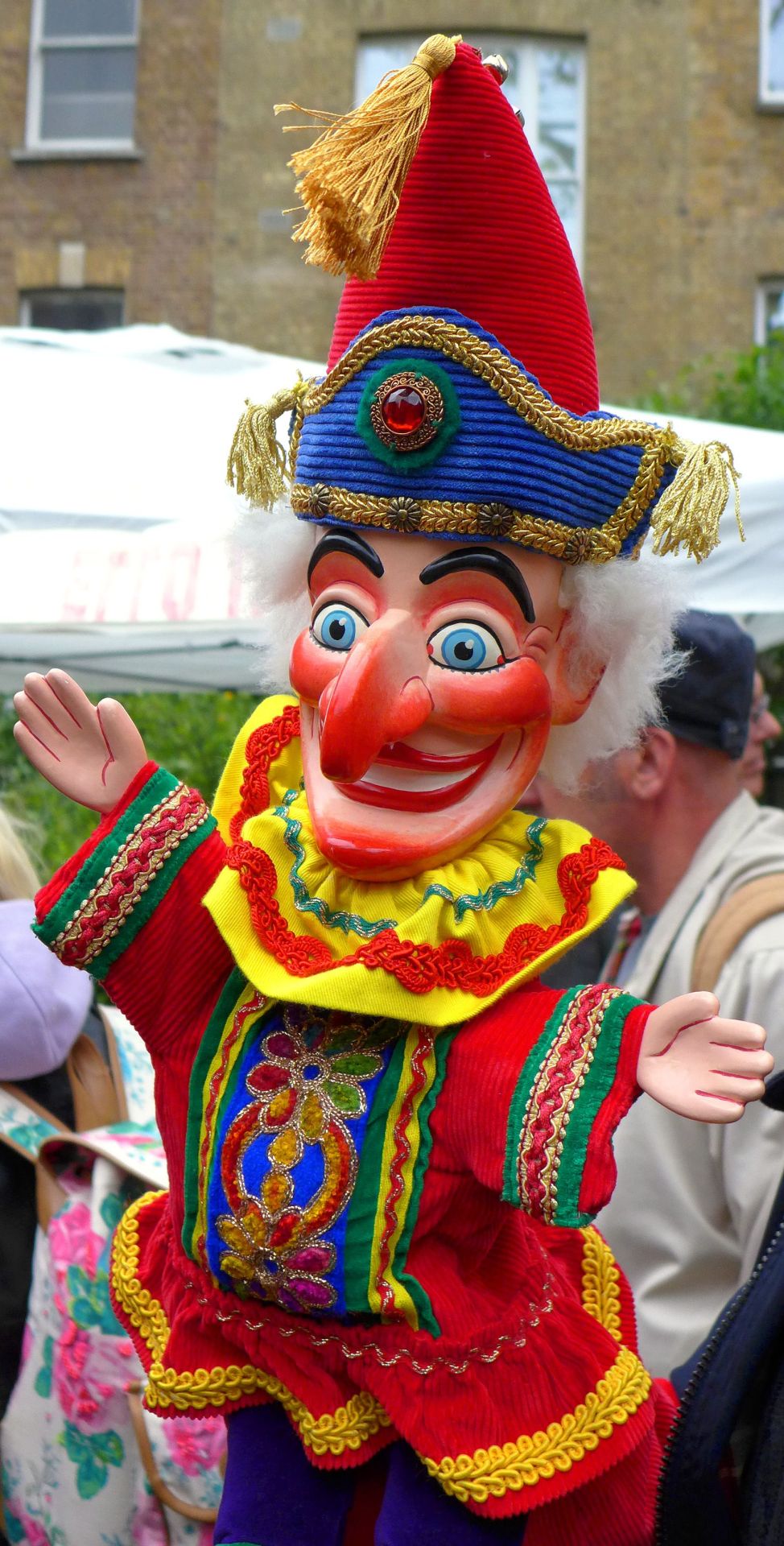
13. Punchinello, a.k.a. Mr. Punch.
The character of Punch, or more appropriately “Punchinello,” is one of the oldest examples of an evil clown in recorded fiction. Now, some of you may be thinking, “What? That silly slapstick puppet show that showed up in ‘Santa Clause 2’? Does that even count?” Well, yes: few people realize the origins of Mr. Punch are really quite disturbing. “Punchinello” is a type of clown character, and the famous figure from “Punch & Judy” is not nearly the innocent weirdo you probably would expect. The origins of Punch indicate he may not even be human, and in the classic Punch & Judy show…yeah, he’s a psychopath. He murders his wife, his child, his neighbor, a policeman, abuses various animals, and even clobbers the Devil himself just to keep his own soul out of Hell! While it’s all given this darkly humorous slapstick veneer, when you really look at the character and his actions, they’re pretty messed up. While I’ve always had a fascination with this folkloric figure, I count him low on the list because he’s really more recognizable as a character in a puppet show than anything else. Which, to me, kind of makes him sit in an odd place compared to other characters on the countdown. And while most people are vaguely familiar with the idea of “Punch & Judy,” I doubt very many really realize how thoroughly INSANE Punchinello is. Other clowns to come are much more overt in their darkness, and most of them are likely more recognizable AS clowns.
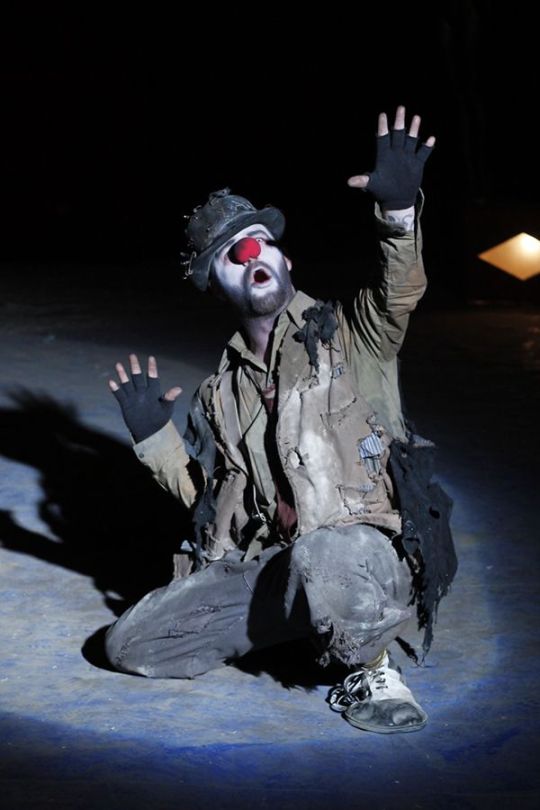
12. The Hobo Clown, from The Devil’s Carnival.
“The Devil’s Carnival” is a short independent musical movie, focused on three people who all end up damned to Hell at the exact same time. They soon discover that Hell is not the medieval fire-and-brimstone wasteland you might expect, but instead takes the form of a perverse carnival and circus. The three sinners thus face a challenge: if they can overcome their greatest sins in life, they will have a chance to go to Heaven. If not, they will be forever doomed to perform in the Carnival, facing death and torture for all eternity as punishment. The Hobo Clown is one of the demons working at the Carnival, and acts as one of two devils assigned to take care of the vain and greedy Miss Merrywood. The character was played by Ivan Moody - most famous as the lead singer of the band Five Finger Death Punch - and gets arguably the best song in the film, “A Penny For a Tale” - performed as he and his fellow carnies torment Merrywood after she fails her test. The film has a motif themed around Aesop’s Fables, and the song analogizes Merrywood’s downfall as a musical retelling of the fable of “The Dog and Her Reflection.” While this dark clown’s role in his respective source is relatively small, it is certainly VERY memorable.

11. Violator, from Spawn.
When most people think of evil clowns in comics, they most likely first think of Batman’s Joker. (And again, we’ll be getting to him soon enough.) However, the Caped Crusader is not the only comic book superhero to have a crazed and murderous clown for an arch-nemesis. Enter Violator - the arch-nemesis of Spawn. While I haven’t actually read much of the Spawn comics, I am primarily familiar with the character thanks to the (admittedly terrible) film adaptation, and (more importantly) the HBO animated series. The former had John Leguizamo, of all people, in the role (and he is arguably the best part of the movie), while the character was voiced by Michael Nicolosi in the TV series. Across all media, however, the character’s basic setup remains the same: Violator is a vaguely bug-like demon who typically takes the form of a crass, vulgar, sardonic clown as a disguise. Ostensibly, he’s in charge of training Spawn, so you’d think they’d be allies…but the Violator is resentful of his position, and only becomes more antagonistic when Spawn goes against his role as leader of Hell’s forces to fight against the Devil. Much of Violator’s evil comes from him trying to one-up his human-born rival, but he’s generally just an awful creature who enjoys suffering and violence in general. When you have a name like “Violator,” I think it’s a given you’re going to be pretty nasty by default.

10. Canio, from Pagliacci.
Alongside Punchinello, this is the oldest example on our list. It’s also the most arguable: while Canio is by no means a hero, it’s debatable how “evil” this clown really is. “Pagliacci” is one of the most well-known operas in the world. Composed by Ruggero Leoncavallo, it tells the story of a troupe of commedia dell’arte performers: chief among them is Canio, who plays the role of the clown Pagliacco in their shows. Canio is depicted as a devoted and kind husband to one of his fellow performers, Nedda…so, when he discovers Nedda is cheating on him with yet another one of their fellow actors, but doesn’t know which one, he plots to find out who her lover is and get revenge. SPOILER ALERT - this ends with Canio, unable to continue his next performance in his emotional distress, murdering both Nedda and her lover, Silvio, before the horrified audience. Canio is a complicated character: on the one hand, he’s typically shown in a sympathetic light: his love for Nedda appears genuine, and he doesn’t seem to be a cruel or abusive husband. HOWEVER, it’s indicated early on that Nedda is afraid of his temper and his possessive attitude towards her, which is why she begins her affair with Silvio. It’s not till he discovers the affair that Canio’s dark side comes out in full force, and even then, one can understand his impulsive and emotional actions. However, Nedda and Silvio aren’t depicted as necessarily bad people, either; they aren’t plotting to do any harm to Canio, and their own relationship seems equally genuine. There’s a lot of gray area here. Ultimately, I would say that double-homicide fueled by rage - however justifiable the act may or may not be - definitely counts Canio in the “Evil Clown” category.
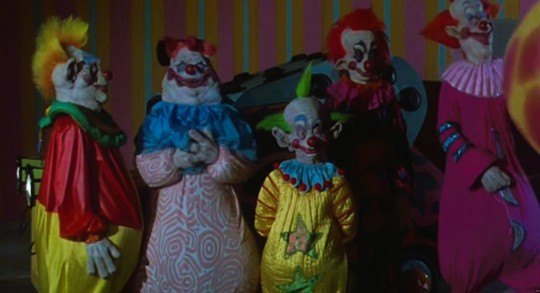
9. Killer Klowns from Outer Space.
While Canio’s villainy is debatable, there’s no such argument to be made with the titular monsters in this cult classic horror-comedy. I mean, it comes with the name: they’re called “Killer Klowns” for a reason. As the title indicates, this movie focuses on a horde of carnivorous, clown-like extraterrestrials, who come to Earth seeking fresh prey to feast upon. The Klowns have powers and weapons that match their circus-like demeanors: they wrap people up in acidic cotton candy cocoons, hatch from eggs that resemble popcorn, have a spaceship that resembles a Big Top, and their only weak spots are their round, red clown noses. While the film is intentionally done in a cheesy, satirical style - fully absorbed in its own silly premise - these Klowns are a great example of what makes the trope so good. They are very funny and utterly bizarre, but they’re also depicted as being totally and completely evil, and have moments where they are genuinely creepy and disturbing. It’s clear that they fully enjoy their own sadistic antics, and take great delight in toying with the humans they kill and consume. The Klowns themselves, and the movie they hail from, are considered classic examples of the concept of Evil Clowns, and were so popular they even spawned a video game, where players are able to take control of the Killer Klowns and hunt down humans in a variety of absurdly despicable ways. I’ve never played the game, but if it’s in any way a match for the movie, I can only imagine it’s as fun as it is freaky.

8. Umlaut, from CarnEvil.
Speaking of video game clowns (as we did at the end of our previous pick), when it comes to the concept of evil circuses, carnivals, and so on, one game title always automatically comes to my mind: “CarnEvil.” A dark staple of arcade galleries from 1998 well into the 2000s, this - like Killer Klowns from Outer Space - was a combo of horror and humor. The game focuses on a thrillseeking protagonist who summons the titular CarnEvil: a twisted amusement park filled with monsters, ghosts, zombies, and…um…evil Christmas elves (no comment), all run by the mad showman, Ludwig Von Tokkentaker. Of course, psychotic killer clowns are all the rage at this place…and the most noteworthy among them all is our “host,” Umlaut. This disembodied jester’s skull - who flies around with his belled collar acting like a helicopter propeller - is the game’s mascot, and acts as Tokkentaker’s second-in-command. Throughout the our gory and grisly adventure, he introduces the different levels, giving each one a darkly humorous limerick to accompany them. In the climactic final sequence aboard his master’s phantom zeppelin, Umlaut confronts the player directly as a mini-boss, preluding the grand showdown between the MC and the leader of CarnEvil. As the most recognizable character from one of the most deliciously deranged arcade experiences of all time, Umlaut definitely deserves a place in my personal top ten.

7. Joker (a.k.a. Rascal), from Smile! Pretty Cure/Glitter Force.
There are quite a number of evil clowns, jesters, harlequins, and so on in the world of anime. A couple that I enjoy who didn’t make the cut include the Moderate Harlequin Alliance from “That Time I Got Reincarnated as a Slime” (yes, both of those titles are things), and Saggi the Dark Clown from “Yu-Gi-Oh!” However, my favorite example from anime would have to be this character. “Smile! Pretty Cure” is one entry in the long-running “Pretty Cure” franchise…and it’s also the ONLY PreCure series I’ve ever seen. (I’m not really a huge fan of Magical Girl shows.) The series is themed around fairy-tales, with three of its major antagonists - Wolfrun, Akaoni, and Majorina - all being characters from famous fairy-tales, and the show as a whole featuring references to other stories and fairy-tale elements throughout. With that said, the main antagonist of the show appears to be a totally original character, and that is this guy. In the original Japanese version, he’s referred to as “Joker.” The English Dub, which retitled the series as “Glitter Force,” changed nearly all of the major character names and other bits of terminology; in that version, the character was renamed “Rascal.” While the original Japanese version is definitely better, I’m going to refer to the character by that name in this description, simply because I find “Rascal” to be a more unique name than “Joker.” The four villains all plan to resurrect a dark entity known as “Emperor Pierrot,” and use his power to - of course - take over the world. It’s eventually revealed that Rascal is actually a part of Pierrot, given his own body and soul, and his greatest desire is to return to his Master and become part of him once again. Rascal will stop at nothing to achieve these goals, and while he at first seems like a goofball, he quickly shows himself to be the scariest and arguably the most wicked of the bunch. And considering his associates include the Big Bad Wolf and the Evil Queen from Snow White, that’s probably saying quite a lot. While the aforementioned Big Bad Wolf, Wolfrun (or “Ulric” in Glitter Force) is my favorite of the villains, Rascal comes at a close second, and was by far the most sinister of the group.

6. Kefka Palazzo, from Final Fantasy.
I’m not super well-versed in the universe of “Final Fantasy,” but I’ve played and seen enough to know a fair bit about Kefka Palazzo. And with what I know about him, there’s no doubt in my mind he’s one of my favorite video game villains, and therefore a shoe-in for a place on this countdown. Once upon a time, Kefka was meant to be a great hero: the first “prototype” of an intended army of Magic Knights, he was experimented on with Magitek (as the name implies, a sort of combo of magic and technology) to give him special powers. The experiment, however, did not go as planned: it DID give Kefka great powers, but also twisted his mind. Kefka is the jolliest nihilist you could ever hope NEVER to meet: he very literally cannot comprehend feelings like love, compassion, and loyalty, and doesn’t understand why people hold so many things as precious. So, like an errant child, he reacts to these things he doesn’t understand by destroying him. While Kefka is manipulative and cunning, his schemes and plots have no great ambition behind them: all he yearns for is death and destruction. Nothing matters to him but killing and ruining other people and the things they hold dear, and no amount of this meaningless horror is enough. He is both a tragic and decidedly deplorable character, and one of the most powerful and dangerous examples of an evil clown on this countdown.

5. The Ghost Clown, from Scooby-Doo, Where Are You?
This may seem like a weird one to place into the Top 5, but for me, it’s a no-brainer. While the Ghost Clown may not be the most threatening and scary of all the clowns on this countdown, he’s one of the first characters I think of whenever I think of the concept, as well as one of my favorite classic Scooby-Doo villains. Appearing in the episode “Bedlam in the Big Top,” the Ghost Clown is a mysterious figure, with a raspy, husky voice and hypnotic powers. It’s revealed that the Ghost Clown is a superstition among circus folk in this world: whenever the Clown shows up, it’s a sign that the circus is doomed. That certainly seems to be the case, as after the appearance of this particular specter, the circus he’s haunting begins to experience a variety of accidents, endangering the performers and causing nearly all of them to leave. It’s therefore up to the Mystery Inc. gang to find a way to stop the Ghost Clown, being the meddling kids they are. In typical fashion, it’s eventually revealed the supposed ghost is a crook in a costume, but I always liked the lore of the Clown being some sort of evil spirit and bad omen, and the Clown himself is just creepy enough to a memorable member of the Scooby-Doo Rogues Gallery. Shaggy, Scooby, and the rest have faced other clowns since then - from a man-eating robot clown to a zombie fond of balloon animals (yes, both of those are in other Scooby-Doo programs) - but none are quite as iconic as the Ghost Clown.

4. Fear, a.k.a. The Clown, from Star Trek: Voyager.
Played by Michael McKean, this creepy customer appeared in my personal favorite episode of “Star Trek: Voyager,” entitled “Thaw.” In this episode, the crew of Voyager stumble upon a group of humanoids - the last of their race - who are being kept in suspended animation, hooked up to an elaborate computer system. It’s revealed that this computer system places the minds of its users into a sort of “dreamworld.” This dreamworld is run by the Clown, a.k.a. “Fear.” Why is he called this? Because the Clown is a literal manifestation of fear itself: he tortures those in his dreamworld with their worst fears and most traumatizing memories, till they literally get scared to death. (Hmmmm…a clown who feeds off of people’s fears, and can make them experience them…where have I heard this before?) While the whole episode is a glorious blend of nightmare fuel and entertaining silliness, courtesy of Fear/the Clown, I think what makes me love it more than anything else is the way it ends. I won’t give away the ending here, but it’s one of the most haunting and emotionally ambiguous conclusions to any Star Trek episode, hands-down.

3. The Chief Clown, from Doctor Who.
From one sci-fi show to another. The Chief Clown is the secondary villain of my personal favorite episode of the Seventh Doctor’s era, “The Greatest Show in the Galaxy.” He is a member of the Psychic Circus: an interstellar circus that has set down its roots on the desert planet of Segonax, and is inviting people from all across the galaxy to tryout and become their next big act. The Doctor and his companion, Ace, go to see the show, and soon find themselves wrapped up in a massive conspiracy, involving extraterrestrial Gods and many buried secrets. The Chief Clown is the ultimate manifestation of the corruption of the circus: it’s indicated that, once upon a time, he was a simple and innocent entertainer, and was considered a genuinely great clown. However, he’s now become obsessed with the power he has over other people, and unlike the other circus performers - who seem more begrudging in their evil deeds, at least to some degree - the Chief Clown has completely embraced the madness. As the episode goes on, he gleefully carries out the will of his near-deity-like masters, and is more than willing to sacrifice not only random people, but his fellow longtime performers, to sate their demands. The character was played by Ian Reddington, and his performance is a major, MAJOR part of what makes the Chief Clown so memorable: he takes even the most simple lines and story beats and finds ways to make them fascinating to watch and listen to as they play out. As I’ve said, I’m typically not afraid of clowns…but this guy might be the one who creeps me out more than any other on the list. (pauses) Well…almost any other, at least. All in due time…

2. Pennywise the Dancing Clown, a.k.a. IT, from Stephen King’s IT.
I was actually tempted, at first, to place Pennywise - the clownish guise of the mysterious entity simply called “IT” from Stephen King’s story of the same name - much lower on the list. Mostly because…to be blunt, I’ve never seen a version of this story that satisfied me to 100%. Every interpretation - the book, the 1990 miniseries, and the two-part cinematic film treatment - has their own share of flaws, and also their fair share of good points. However, as time has gone on…while I have noticed more and more the issues with the story itself, I have also, conversely, gained more and more of an appreciation of the character of Pennywise. Whenever people think of the phrase “Evil Clown,” he (it?) is one of the first characters folks think of or reference. Every incarnation of Pennywise is slightly different, but all of them share the same basic idea: the clown is the preferred “costume” of a shapeshifting creature, referred to as “IT,” which feeds on people’s fear…and then feeds on the people themselves. What I love most about Pennywise in the book is the way IT is actually written: for all the problems the novel has, the monster, itself, is honestly so incredibly disturbing. Something about the way King describes the creature and its thoughts and words and so on makes it feel so unnervingly alien and cosmic. The screen treatments don’t capture this same nigh-Lovecraftian idea, but they are memorable in their own ways: Tim Curry’s delightfully over-the-top performance often feels more comical than truly chilling, but is certainly a memorable and entertaining execution, and it’s easy to see why so many people still feel scared of him, or at least enjoy him, to this day. Bill Skarsgard’s Pennywise upped the horror factor to the max, but still had a decent amount of humor and even manipulative guile to him, and gave the character a wonderful arc, as the eater of worlds and master of fear learns what it’s like to feel fear itself. Whatever version you prefer, there are few twisted harlequins quite as iconic as Pennywise the Dancing Clown.
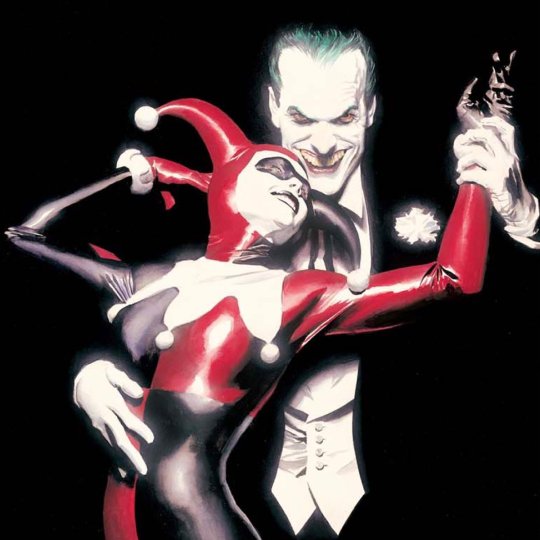
1. The Joker & Harley Quinn, from Batman.
Yep. It’s finally time. You all knew this one was coming. And yes, I’m including Harley here, too: while I’ve personally become a bit annoyed with Harley’s ridiculous levels of misused popularity over the years - and nowadays she barely even counts as an “evil” clown, a lot of the time - I’d feel remiss to leave her out of the running entirely. The fact that it bothers me so many of her redesigns and reinventions almost seem to forget the fact she’s meant to evoke the iconography of a classic clown and jester should say something on its own. However, I’ll admit it’s mostly the Joker we’re talking about here. The Clown Prince of Crime is arguably the most famous supervillain of all time, and is one of the longest-lasting killer clowns on this countdown: he’s been around since 1940. I think the only clowns who have been around longer than him are Pagliacci and Punchinello; considering the latter has been around since the 17th century, and the former has been around since the late 1800s…yeah, I’d say the Joker’s near-85-year-run is still pretty darn impressive. If you need proof of just how much influence this character has had on me, if nothing else, you don’t even have to look at other things I’ve written; just go back over this list and see how many times I hinted at the Joker’s arrival, and how many characters here bear some resemblance - however intentional or not - to the Ace of Knaves. There’s really not much more I even need to say to justify this decision: in my opinion, the Joker (and, to a lesser degree, dear Harley Quinn) are the ultimate couple of Evil Clowns. “Laugh, clown, laugh.”
HONORABLE MENTIONS INCLUDE…
Sweet Tooth, from Twisted Metal. (I don’t really know anything about this character or these games, but from what little I’ve learned, he seems fun in an utterly horrifying way.)
The Clown Doctors, from Pee-Wee’s Big Adventure. (Also the Clown Statue. Lots of evil clowns here.)
The Fireman Clown, from The Brave Little Toaster. (GOOD LORD, THIS THING WAS SCARY.)
Krusty the Clown AND Sideshow Bob, from The Simpsons. (Not sure how much either of these guys count - Krusty seems more “cynical” than “evil,” and Bob barely even qualifies as a clown - hence why they’re only Honorable Mentions.)
The Clown Doll, from Poltergeist. (I felt this fit more in the vein of “creepy toys” than “evil clowns,” but still worthy of an Honorable Mention.)
Mad Pierrot, from Cowboy Bebop. (He may not wear makeup in the original anime, but I still say he counts.)
#list#countdown#best#favorites#horror#villains#evil clowns#killer clowns#scary clowns#halloween#top 15#joker#harley quinn#batman#dc#pennywise#stephen king's it#pennywise the dancing clown#chief clown#doctor who#star trek voyager#ghost clown#scooby-doo#kefka palazzo#final fantasy#rascal#glitter force#smile precure#smile! pretty cure#umlaut
15 notes
·
View notes
Text
I'm not a big fan of character AI but this is fucking hilarious
GUYS GUYS GUYS G I WANT YOU ALL TO LOOK AT THIS PERSONS CHARACTER AI LIST

GIRL HELP ITS 12 IN THE MORNING IM CRYING
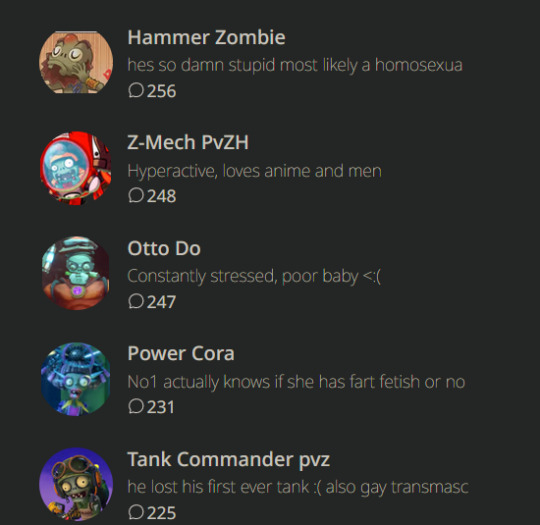

fuUGCK I HAVE TEARS STREAMIGN HELP



THE FUCKING ELECTRO BRAINZ SHADE WHY THIS IS SO AMAZING

IHAVETENNISBALLINASS IF YOURE OUT THERE YOURE FUCKING HILARIOUS
#READ THE DESCRIPTIONS IF YOU HAVEN'T I'M WHEEZING#i need to tell my friend about the general supremo one that's his favorite character#we love old zombie men around here#THE USERNAME MAKES IT SO MUCH BETTER
26 notes
·
View notes
Text
the man ever
elcome to me uh General Supremo posting
H idk what to say rly i dint wantbto be active here anymore

anyways i want ti do unspeakable shit to this old fuck🥰🥰🥰🥰
#i love general supremo#i love old crusty men#i hope he explodes affectionately#HES MINE DONT TOUCH HIM OR YOULL HAVE A BAD TIMW GRRRR/J
2 notes
·
View notes
Photo

Toyotomi Hideyoshi
Toyotomi Hideyoshi (1537-1598 CE) was a Japanese military leader who, along with his predecessor Oda Nobunaga (1534-1582 CE) and his successor Tokugawa Ieyasu (1543-1616 CE), is credited with unifying Japan in the 16th century CE. Hideyoshi rose from a humble background to become the country's military supremo, and he then reorganised the class system, instigated tax reforms, built castles, restored temples, and launched two invasions of Korea. Hideyoshi's foreign ambitions may have met with disaster but his restructuring of the state would establish the social and political norms which endured in Japan until the 19th century CE.
Nobunaga & Taking Power
Hideyoshi, originally named Kinoshita Hiyoshimaru, was born into a peasant family in 1537 CE. As a young man, he joined the army of the military leader/warlord Oda Nobunaga and rose through the ranks to eventually become a general and the most important military commander in Nobunaga's endeavour to conquer rival feudal lords and so unify Japan. Hideyoshi might have gained his overlord's respect as a commander but his small physique resulted in Nobunaga giving him the unflattering nickname of Saru or 'monkey.'
In 1582 CE Nobunaga was betrayed by one of his vassals, Akechi Mitsuhide, and obliged to commit suicide to avoid being handed over to his rivals. Hideyoshi, first killing Mitsuhide, then manoeuvred to gain the support of Nobunaga's relations and other important daimyo or feudal lords. He was thus able to install himself as the new military supremo in Japan, as yet, still only half of which was unified.
Hideyoshi, now commanding a force of some 200,000 men, successfully combined military campaigns with diplomacy amongst his rival daimyo to establish himself as the ruler of most of Japan in 1590 CE. In a five-year period beginning in 1585 CE, Hideyoshi had attacked western Japan, Kyushu and Shikoku. Success followed success, but there were some troublesome battles, notably the 100-day siege needed to take the castle of Odawara, the seat of the powerful Hojo family. The castle finally fell in 1590 CE and with it the last obstacle to Hideyoshi's rule. Other enemies had proved more amenable to negotiation and were offered to keep some of their lands. Notable amongst these were the Shimazu of Satsuma and the Mori of Choshu.
As with other military leaders before and after, Hideyoshi might have dominated the field of battle but he still sought legitimacy from the monarchy. To gain royal favour from the emperor who had no real power of his own, he gave money for court ceremonies and rebuilt the palace at the capital Heiankyo (Kyoto). Hideyoshi added another, much more bizarre claim to his legitimacy to rule by stating his belief that he was descended from the Shinto sun god. There were even performances of Noh theatre telling this story which Hideyoshi himself performed in. The cherry on the cake came when Hideyoshi adopted the prestigious family name of Fujiwara, began to call himself Toyotomi Hideyoshi, and ultimately awarded himself the title of Taiko ('retired regent'), which was higher than that of the shogun, the title his military predecessors had taken.
Continue reading...
23 notes
·
View notes
Text
@judit_sinhache
El Mundo difunde un BULO sobre el pacto que la Fiscalía ofrece a la pareja de Ayuso, MAR, su mano derecha, lo celebra en Twitter La Fiscalía saca una nota para desmentir el bulo ¿A quien creéis que ha imputado el Supremo, al que difunde o al que desmiente el bulo? Efectivamente, el TS imputa al Fiscal General del Estado, la justicia ya ni disimula para quien trabaja?
6 notes
·
View notes
Text
LA PRINCESA DE ASTURIAS O LOS DESEOS DE ESPAÑA Rafael Dávila Álvarez
Sigo la lectura de Carlos Seco Serrano en un libro coordinado por Julián Marías 25 años de reinado de Juan Carlos I. De necesaria lectura para entender ese periodo de la historia en la palabra de los 25 autores que mejor podrían hacerlo. Se lo recomiendo para enderezarse en estos tiempos de tribulación para España. Carlos Seco Serrano en su aportación La monarquía, encarnación total de la…

View On WordPress
#a Historia; en la Ley: el acatamiento de la Constitución; en el Mando Supremo de las Fuerzas Armadas#academia general militar de zaragoza#blog generaldavila.com#Doña Leonor#Jura la Constitución#la Hispanidad#la princesa de asturias#mando supremo de las fuerzas armadas#rafael davila alvarez
0 notes
Text
¿CONOCIAS LA HISTORIA DE “LA CAOBA”? EL ESCÁNDALO DE LA DICTADURA DE PRIMO DE RIVERA
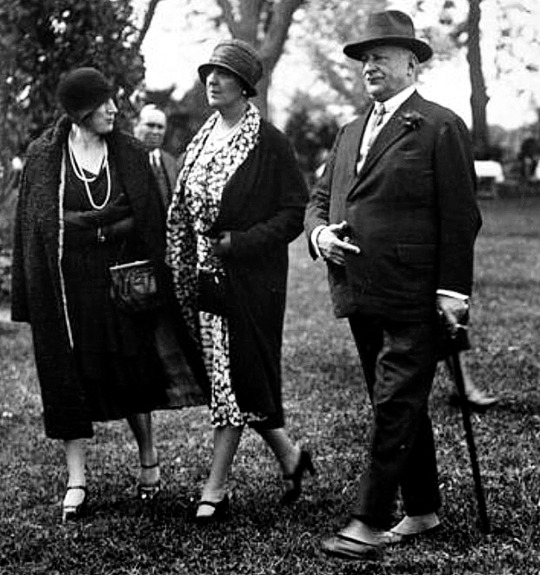
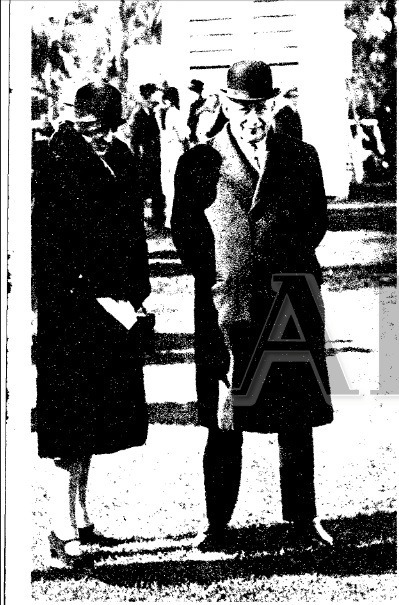
Al comienzo de los años 20 del siglo XX, (1924) la cocaína y la morfina eran de consumo habitual en cabarets y locales nocturnos de ciudades como Madrid, Barcelona, Valencia. Francia parecía ejercer una perniciosa influencia sobre nuestras fronteras. Se temía un contagio de una modernidad sobre la que poco se sabía realmente.
Sexo y droga, una combinación difícil de superar, ni siquiera para el dictador Miguel Primo de Rivera que no supo librarse de sus embrujos y fue capaz de destituir a un juez que detuvo a su amante favorita, una prostituta andaluza conocida como La “Caoba” que además mercadeaba con la cocaína.
La “Caoba” frecuentaba el tablao flamenco, Villa Rosa, que nació de la mano de dos banderilleros y un picador como freiduría de” pescaito” y finos, entre la calle Gorguera y el callejón Álvarez Gato en 1911, y que en 1924 contaba con buenos cantaores como Antonio Chacón. En los reservados del Villa Rosa solían perderse la elite política, militar, burgueses y el rey Alfonso XIII.
Pero el protagonista del escándalo fue el general Miguel Primo de Rivera, que sirvió en Marruecos, Cuba y Filipinas, estuvo seis años casado y tuvo seis hijos, su esposa Casilda Saenz de Heredia murió precisamente de parto. En su viudez, el general se convirtió en asiduo de casas de juego,cabarés, music halls, se rodeó de numerosas amantes como la cupletista Raquel Meller, prostitutas, sobre todo, de la ya nombrada, la “Caoba” que fue detenida y procesada por tráfico de drogas y chantaje a un empresario.
Fue procesada por el juez, don José Prendes Pando. Es entonces cuando el dictador Primo de Rivera indica al magistrado que deje libre a su amante, aduciendo que él era protector de jóvenes alegres. No cejó hasta que el juez fue enviado a Albacete, expulsado de la carrera judicial y el presidente del Tribunal Supremo, don Buenaventura Muñoz, que respaldó al magistrado, fue jubilado anticipadamente.
Hubo quien se atrevió a criticar abiertamente al dictador, como El Colegio de Abogados de Madrid, quien en junta general alzaron sus voces enérgicas y condenaron la intromisión del Dictador, emitiendo una nota de protesta. También se criticó en los círculos intelectuales alrededor del Ateneo de Madrid. Así lo hicieron su presidente, don Rodrigo Soriano y un miembro tan destacado como don Miguel de Unamuno, entonces vicerrector de la Universidad de Salamanca.
La “Caoba” salió de la cárcel y a ambos ateneístas la crítica les costó el destierro a Fuerteventura. Dicen que la última frase del catedrático en su clase de la Universidad de Salamanca fue: “Para el día próximo, lección siguiente”. El Ateneo fue clausurado.
El Heraldo de Madrid, habló tambien sobre el tema, pero para evitar represalias contó que el suceso se había producido en Bulgaria y el protagonista era el primer ministro de este país.
Unamuno al año del exilio publicó De Fuerteventura a París. Diario íntimo de confinamiento y destierro vertido en sonetos por Unamuno, una colección de textos y referencias a una España que se le negaba. También habló de La Caoba :
«Famoso se hizo el caso de la ramera, vendedora de drogas prohibidas por la ley y conocida por La Caoba, a la que un juez de Madrid hizo detener para registrar su casa y el Dictador le obligó a que la soltase y renunciara a procesarla por salir fiador de ella.
Cuando el caso se hizo público y el Rey, según parece, le llamó sobre ello la atención, se le revolvió la ingénita botaratería, perdió los estribos — no la cabeza, que no la tiene — y procedió contra el juez tratando de defenderse en unas notas en que se declaraba protector de las jóvenes alegres.
Aquellas notas han sido uno de los baldones más bochornosos que se han echado sobre España, a la que el Dictador ha tratado como a otra ramera de las que ha conocido en los burdeles. Se ha complacido en mostrar sus vergüenzas y en sobárselas delante de ella«.
37 notes
·
View notes